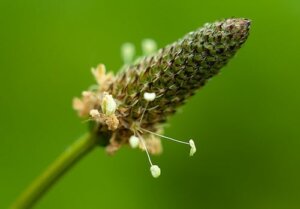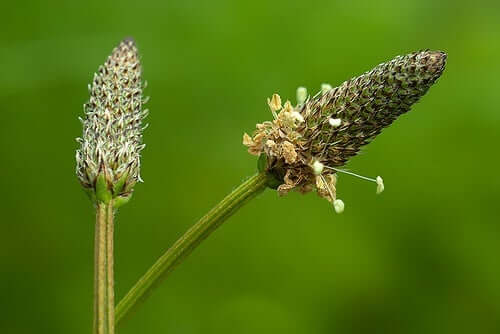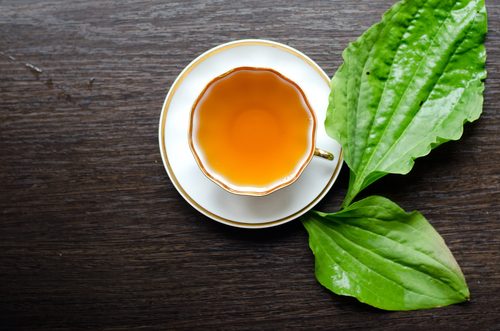How to Use Plantain, an Ancient Herb


Reviewed and approved by the biologist Cesar Paul González
The use of plantain provides many benefits. The properties of this plant are so many and its applications are so varied that we should always have it in our homes.
This is a plant that can help us to treat many problems that we often suffer from, such as cough and bronchial conditions, topical (or local) or internal inflammatory manifestations, and, to some extent, even certain infections.
What is plantain? Where is it cultivated?
Plantain is a perennial plant that’s easily found in Europe and also in Asia and America. It has very characteristic leaves up to 15 centimeters long and yellowish flowers in spikes.

The large plantain (Plantago major L.) is a plant that grows without too many demands in the most wandering places and can be found in farmland or along roadsides, but also in fields rich in organic fertilizers or farms.
It’s very rustic and easy to grow, requiring no special care. Therefore, you can even have it in your garden or potted throughout the year.
Harvesting and storage of plantain
The leaves are collected during the spring or summer. They should be dried in a shady and airy place (drying in the sun is faster, but greatly consumes the properties of any plant to be dried). Afterward, keep them in clean and airtight containers.
We think you may also enjoy reading this article: Five Medicinal Plants to Manage the Pain of Rheumatoid Arthritis
Composition and properties of plantain
The use of plantain is justified because its composition contains a multitude of beneficial substances. Researchers have found that it contains several active compounds such as flavonoids, polysaccharides, terpenoids, lipids and iridoid glycosides. We’ll highlight some of its other agents:
- Mucilage, a substance that helps in the case of respiratory ailments.
- Tannins, which give it its astringent qualities.
- Oleic and linoleic acids (omega 9 and omega 6 fatty acids).
- It also has an important presence of caffeic acid. This makes it a very high natural source of antioxidants, with a very interesting use as we shall see.
In addition to all of these, plantain contains alkaloids of the plantagonin and indicain type, as well as vitamin C. These substances give it antioxidant, healing, and immune-boosting properties, among others.
5 medicinal uses of plantain

There are many benefits of using plantain. We’ve already seen some of them. Let’s now explain some others that will convince you of the benefits of this plant.
1. It accelerates healing
There’s evidence that plantain ointment is safe and effective for treating second-degree burn wounds due to its healing properties. In addition, it’s an analgesic and antimicrobial compound that may contribute to the improvement of symptoms and recovery prognosis.
It’s also a safe plant, as no side effects have been reported from its use. The best way to take advantage of it is with topical products that include it in their ingredients, although you can also make poultices with its leaves.
2. Plantain is a dermal regenerator
It’s also an excellent dermal regulator – that is, it disinfects and heals sores and wounds, promoting skin regeneration. This property makes it very suitable for the treatment of dermatitis, sores, pustules, and other similar conditions.
This is due to its richness in tannins and allantoin content, a substance that promotes epidermal cell growth and promotes the regeneration of its cells. Plantain is used in the cosmetic industry for regenerating creams because of this property.
It’s known that, together with aloe vera, it improves collagen bundle synthesis and revascularization in skin lesions. It has also been suggested that it can protect against the inclement UV rays of the sun.
A simple fresh leaf of this plant, when well washed and applied on a wound, will help to stop the flow of blood, heal it and prevent the risk of infection.
3. It can help treat respiratory tract conditions

There’s evidence that plantain has anti-inflammatory and antibacterial properties. Therefore, it’s used in case of sore throat, sore mouth, and even sores. It is also effective in the case of aphonia.
Due to its mild expectorant properties, it’s indicated to reduce inflammation of the respiratory tract and expel mucus, which combined gives us a use for the treatment of cough, pharyngitis, laryngitis, and bronchitis.
To do this we will make homemade syrup, crushing its leaves, and, once filtered, mix the liquid obtained in equal parts with sugar and dissolve it all in a water bath, taking three tablespoons a day of the syrup.
Like this article? You may also like to read: Spinach, Carrots, and Lemon: A Medicinal Drink to Eliminate Toxins
4. It improves the body’s defenses
The use of plantain is indicated for those who have problems with low defenses because it stimulates the production of antibodies. It also improves and strengthens our immune system, it has immunomodulatory properties. In addition, it’s known to be an antioxidant and free radical scavenger.
5. Plantain helps the digestive system

The use of plantain is effective in stopping diarrhea. It’s also useful in cases of colitis and enterocolitis and can help reduce the pain caused by gastric ulcers. Experts attribute to it the quality of improving intestinal health.
All this is because of its astringent and demulcent properties (it contains viscous substances that perform local protection, similar to the mucus in our internal membranes). To take advantage of them, take an infusion of dried leaves three times a day.
Also, when it comes to its seeds, it’s useful for constipation. You just have to consume a liquid made from boiling its seeds along with plenty of water. Three tablespoons daily with at least 8 glasses of water will help.
Other benefits of using plantain
The medicinal uses of plantain that we’ve just described all have some scientific support. However, we’ll leave you with other possible benefits that are popularly attributed to it but still require more studies to verify:
- It’s used to reduce the production of aflatoxins (toxins produced by fungi of the genus Aspergillus).
- Some people use plantain as an emollient by making an infusion of dried leaves at 5% and drinking three cups daily.
- It can increase urine production, so it’s used as a natural diuretic.
- It calms in case of insect bites.
- It’s a good remedy to relieve tired, red, or inflamed eyes. For this purpose, eye baths are made with the liquid resulting from the decoction of 5 tablespoons of dried leaves per liter of water for 1/4 hour.
As you can see, plantain is an ally for our health in many different aspects. Do not hesitate to have this plant always at hand. However, if you’re under permanent pharmacological treatment or have a health condition consult your doctor before opting for its use.
Photo courtesy of Koke Zúñiga
All cited sources were thoroughly reviewed by our team to ensure their quality, reliability, currency, and validity. The bibliography of this article was considered reliable and of academic or scientific accuracy.
- Adom MB, Taher M, Mutalabisin MF, Amri MS, Abdul Kudos MB, Wan Sulaiman MWA, Sengupta P, Susanti D. Chemical constituents and medical benefits of Plantago major. Biomed Pharmacother. 2017 Dec;96:348-360.
- Ashkani-Esfahani S, Khoshneviszadeh M, Noorafshan A, Miri R, Rafiee S, Hemyari K, Kardeh S, Koohi Hosseinabadi O, Fani D, Faridi E. The Healing Effect of Plantago Major and Aloe Vera Mixture in Excisional Full Thickness Skin Wounds: Stereological Study. World J Plast Surg. 2019 Jan;8(1):51-57.
- de Cássia Israel Cardoso F, Peruzzo Apolinário P, da Silva Cunha Breder J, Paranhos T, Ceretta Oliveira H, Dini Polidoro A, Souza Oliveira Kumakura AR, Melo Lima MH. A protocol for systematic review of Plantago major L. effectiveness in accelerating wound-healing in animal models. Syst Rev. 2019 Dec 23;8(1):337.
- Farcaș AD, Moț AC, Pârvu AE, Toma VA, Popa MA, Mihai MC, Sevastre B, Roman I, Vlase L, Pârvu M. In Vivo Pharmacological and Anti-inflammatory Evaluation of Xerophyte Plantago sempervirens Crantz. Oxid Med Cell Longev. 2019 Jun 2;2019:5049643.
- Keshavarzi A, Montaseri H, Akrami R, Moradi Sarvestani H, Khosravi F, Foolad S, Zardosht M, Zareie S, Saharkhiz MJ, Shahriarirad R. Therapeutic Efficacy of Great Plantain (Plantago major L.) in the Treatment of Second-Degree Burn Wounds: A Case-Control Study. Int J Clin Pract. 2022 Aug 1;2022:4923277.
- Nizioł-Łukaszewska, Z., Gaweł-Bęben, K., Rybczyńska-Tkaczyk, K., Jakubczyk, A., Karaś, M., & Bujak, T. Biochemical properties, UV-protecting and fibroblast growth-stimulating activity of Plantago lanceolata L. extracts. Industrial Crops and Products. 2019; 138: 111453.
- Samuelsen AB. The traditional uses, chemical constituents and biological activities of Plantago major L. A review. J Ethnopharmacol. 2000 Jul;71(1-2):1-21.
- Wegener T, Kraft K. Der Spitzwegerich (Plantago lanceolata L.): Reizlinderung bei Infektionen der oberen Atemwege [Plantain (Plantago lanceolata L.): anti-inflammatory action in upper respiratory tract infections]. Wien Med Wochenschr. 1999;149(8-10):211-6.
- Zhang S, Hu J, Sun Y, Tan H, Yin J, Geng F, Nie S. Review of structure and bioactivity of the Plantago (Plantaginaceae) polysaccharides. Food Chem X. 2021 Nov 12;12:100158.
This text is provided for informational purposes only and does not replace consultation with a professional. If in doubt, consult your specialist.








